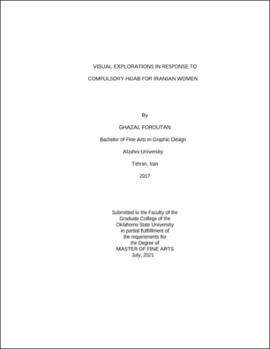| dc.contributor.advisor | Jahanshahi, Pouya | |
| dc.contributor.author | Foroutan, Ghazal | |
| dc.date.accessioned | 2022-01-21T19:33:41Z | |
| dc.date.available | 2022-01-21T19:33:41Z | |
| dc.date.issued | 2021-07 | |
| dc.identifier.uri | https://hdl.handle.net/11244/333797 | |
| dc.description.abstract | Hijab or veiling became mandatory in Iran after the Iranian revolution of 1979 and the establishment of the Islamic government. The hijab mandate in Iran means women need to cover their head hair with a headscarf and wear a long, loose cardigan (manteau or chador) along with long pants to cover their bodies completely. This is theoretically to protect them from being stared at or harassed by men. Iranian women are required to wear the hijab in public every day of their lives. Girls start wearing the hijab when they start school at the age of 7 years. It is not mandatory for them to wear it outside of school until the age of 9 years. That age is known for being when girls start puberty and start seeing changes in their bodies. From age 9 years and older, women and girls not following the hijab rules face consequences such as being arrested, jailed, or harassed or, depending on the situation, being required to live in exile. | |
| dc.description.abstract | The main goal of this thesis is to raise awareness of the hijab laws as an oppressive act towards Iranian women. The related thesis projects will give their viewers a stronger understanding of what compulsory hijab law is in Iran. Furthermore, the related projects represent the designer's way of protesting using the visual language of graphic design. It shows how graphics can be a powerful form for bringing awareness and a sense of empathy to viewers. The final exhibition includes a series of projects engaged with various media such as history textbooks, magazine covers, printed posters, video motion graphics, experience design, and photography. | |
| dc.description.abstract | Each project tells a story of how compulsory hijab has affected Iranian women's lives over the past 40 years. The primary target audience of this research is Iranian men and women who have been silent about this suppression over the years. It is also intended for women who have blindly forced their daughters to wear a hijab without educating them about Islam and their choices. The secondary audience is non-Iranians who see the work in the gallery or online. Finally, this thesis is meant to be a part of the Iranian women's movement against compulsory hijab and to bring up the subject of gender equality in Iran. | |
| dc.description.abstract | Note: This research and its visual explorations are only intended to bring awareness of the enforcement of the hijab for Iranian women who wish to have the choice to wear or not wear hijab. This is presented with all due respect to women who want to wear the Islamic hijab willingly and not by force. It is not intended to explore both sides of the argument of the hijab and is not comprehensive research on this subject. | |
| dc.format | application/pdf | |
| dc.language | en_US | |
| dc.rights | Copyright is held by the author who has granted the Oklahoma State University Library the non-exclusive right to share this material in its institutional repository. Contact Digital Library Services at lib-dls@okstate.edu or 405-744-9161 for the permission policy on the use, reproduction or distribution of this material. | |
| dc.title | Visual explorations in response to compulsory hijab for Iranian women | |
| dc.contributor.committeeMember | Renyer, Justen | |
| dc.contributor.committeeMember | Maione, Lisa | |
| osu.filename | Foroutan_okstate_0664M_17270.pdf | |
| osu.accesstype | Open Access | |
| dc.type.genre | Thesis | |
| dc.type.material | Text | |
| dc.subject.keywords | compulsory hijab | |
| dc.subject.keywords | design activism | |
| dc.subject.keywords | design for good | |
| dc.subject.keywords | iranian women | |
| dc.subject.keywords | visual exploration | |
| thesis.degree.discipline | Graphic Design | |
| thesis.degree.grantor | Oklahoma State University | |
